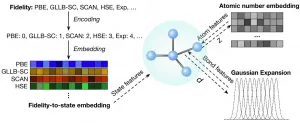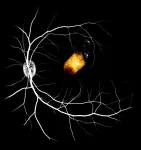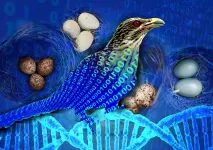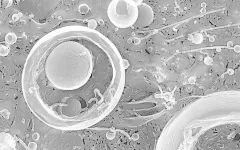New method makes better predictions of material properties using low quality data
Multi-fidelity approach also enables property prediction for disordered materials
2021-01-14
(Press-News.org) Advancements in energy technologies, healthcare, semiconductors and food production all have one thing in common: they rely on developing new materials--new combinations of atoms--that have specific properties enabling them to perform a needed function. In the not-too-distant past, the only way to know what properties a material had was by performing experimental measurements or using very expensive computations.
More recently, scientists have been using machine learning algorithms to rapidly predict the properties that certain arrangements of atoms would have. The challenge with this approach is it requires a lot of highly accurate data to train the model, which often does not exist.
By combining large amounts of low-fidelity data with the smaller quantities of high-fidelity data, nanoengineers from the Materials Virtual Lab at UC San Diego have developed a new machine learning method to predict the properties of materials with more accuracy than existing models. Crucially, their approach is also the first to predict the properties of disordered materials--those with atomic sites that can be occupied by more than one element, or can be vacant. They detailed their multi-fidelity graph networks approach on January 14 in Nature Computational Science.
"When you are designing a new material, one of the key things you want to know is if the material is likely to be stable, and what kind of properties it has," said Shyue Ping Ong, a professor of nanoengineering at the UC San Diego Jacobs School of Engineering and the paper's corresponding author. "The fundamental problem is that valuable accurate data, such as experimental measurements, is difficult to come by, even though we have large databases of less accurate computed properties. Here, we try to get the best of both worlds - combine the large low-fidelity data and the smaller high-fidelity data to improve the models' accuracy in high value predictions."
While other multi-fidelity approaches exist, these methods do not scale well or are limited to only two fidelities of data. They are not as accurate or dynamic as this new multi-fidelity graph network approach, which can work with an unlimited number of data fidelities and can be scaled up very quickly.
In this paper, the nanoengineers looked specifically at materials' band gaps--a property used to determine electrical conductivity, the color of the material, solar cell efficiency, and more --as a proof-of-concept. Their multi-fidelity graph networks led to a 22-45% decrease in the mean absolute errors of experimental band-gap predictions, compared to a traditional single-fidelity approach. The researchers also showed that their approach can predict high-fidelity molecular energies accurately as well.
"There is no fundamental limitation as to what properties this can be applied to," said Ong. "The question is which kind of properties we have data on."
In the near term, Ong's team plans to use this new method to develop better materials for energy storage, photovoltaic cells and semiconductor devices.
While predicting the properties of ordered materials, the team made another serendipitous discovery--in the graph deep learning model they use, atomic attributes are represented as a learned length-16 embedding vector. By interpolating these learned embedding vectors, the researchers found they were able to also create a predictive model for disordered materials, which have atomic sites that can be occupied by more than one element or can be vacant at times, making them harder to study using traditional methods.
"While the bulk of computational and machine learning works have focused on ordered materials, disordered compounds actually form the majority of known materials," said Chi Chen, an assistant project scientist in Ong's lab, and first author of the paper. "Using this approach, multi-fidelity graph network models can reproduce trends in the band gaps in disordered materials to good accuracy."
This opens the door to much faster and more accurate design of new materials to meet key societal needs.
"What we show in this work is you can actually adapt a machine learning algorithm to predict the properties of disordered materials. In other words, now we are able to do materials discovery and prediction across the entire space of both ordered and disordered materials rather than just ordered materials," said Ong. "As far as we know, that is a first."
INFORMATION:
The work was supported by the Materials Project, an open-science initiative to make the properties of all known materials publicly available to accelerate materials innovation, funded by the U.S. Department of Energy, Office of Science, Office of Basic Energy Sciences, Materials Sciences and Engineering Division (DE-AC02-05-CH11231: Materials Project program KC23MP). All data and models from this work have also been made publicly available via the Materials Virtual Lab's megnet repository on Github.
[Attachments] See images for this press release:

ELSE PRESS RELEASES FROM THIS DATE:
2021-01-14
Retinal cells derived from adult human eye stem cells survived when transplanted into the eyes of monkeys, an important early step in the validation of this approach for treating blindness, according to a study by Liu, et al recently published in Stem Cell Reports. The retinal pigment epithelium (RPE), a layer of pigmented cells in the retina, is essential for sustaining normal vision. Blindness due to RPE dysfunction, such as macular degeneration, affects about 200 million people worldwide.
To restore this population of cells, researchers extracted retinal stem cells from donated cadaver adult eyes, grew them into RPE cells and transplanted them into the eyes of monkeys. ...
2021-01-14
Retinal cells derived from a cadaver human eye survived when transplanted into the eyes of primate models, an important advance in the development of cell therapy to treat blindness, according to a study published on January 14 in Stem Cell Reports.
The retinal pigment epithelium (RPE), a layer of pigmented cells in the retina, functions as a barrier and regulator in the eye to maintain normal vision. RPE dysfunction can lead to eye disorders including macular degeneration and can cause blindness, which affects about 200 million people worldwide.
To restore this population of cells, ...
2021-01-14
A major roadblock to computational design of high-entropy alloys has been removed, according to scientists at Iowa State University and Lehigh University. Engineers from the Ames Lab and Lehigh University's Department of Mechanical Engineering and Mechanics have developed a process that reduces search time used for predictive design 13,000-fold.
According to Ganesh Balasubramanian, an associate professor at Lehigh, the goal of the team's research was to accelerate the computational modeling of complex alloys. The tools available for creating random distribution of atoms in materials simulation models, he says, have been used for many, many years now and are limited in ...
2021-01-14
What The Study Did: The number of patients undergoing cancer screening tests and of subsequent cancer diagnoses during the COVID-19 pandemic in the largest health care system in the northeastern United States was assessed in this study.
Authors: Toni K. Choueiri, M.D., of the Dana-Farber Cancer Institute and Quoc-Dien Trinh, M.D., of Brigham and Women's Hospital in Boston, are the corresponding authors.
To access the embargoed study: Visit our For The Media website at this link https://media.jamanetwork.com/
(doi:10.1001/jamaoncol.2020.7600)
Editor's Note: The article includes conflict ...
2021-01-14
What The Study Did: Which demographic and socioeconomic factors were associated with patient participation in telehealth during the COVID-19 pandemic surge was examined in this observational study.
Authors: Ilaaf Darrat, M.D., M.B.A., of the Henry Ford Hospital in Detroit, is the corresponding author.
To access the embargoed study: Visit our For The Media website at this link https://media.jamanetwork.com/
(doi:10.1001/jamaoto.2020.5161)
Editor's Note: Please see the article for additional information, including other authors, author contributions and affiliations, conflict of interest and financial disclosures, ...
2021-01-14
What The Study Did: Researchers investigated the association of home confinement during the COVID-19 outbreak with myopia (nearsightedness) development in school-age children in China.
Authors: Xuehan Qian, M.D., Ph.D., of Tianjin Medical University Eye Hospital in Tianjin, China, is the corresponding author. This is an open access article distributed under the terms of the CC-BY License. © 2021 Wang J et al. JAMA Ophthalmology.
To access the embargoed study: Visit our For The Media website at this link https://media.jamanetwork.com/
(doi:10.1001/jamaophthalmol.2020.6239)
Editor's Note: The ...
2021-01-14
Cardiac rehabilitation is a therapy that combines guided exercise along with heart-healthy lifestyle education that can be life-saving for the majority of people who have had a major cardiac event, such as a heart attack. However, it is underutilized in the United States, with many hospitals referring just 20 percent or fewer of their eligible patients, largely because the referral process can be cumbersome. But new research shows that implementing a simple, easy to use "opt-out" pathway in the electronic health record drastically increased the rate of referrals, which could lead to fewer rehospitalizations and even lowered mortality. Led by researchers at the Perelman School of Medicine ...
2021-01-14
What The Study Did: Researchers in this randomized clinical trial compared injection-site pain and other reactions among adults age 65 and older who received flu vaccines.
Author: Kenneth E. Schmader, M.D., of the Duke University School of Medicine in Durham, North Carolina, is the corresponding author.
To access the embargoed study: Visit our For The Media website at this link https://media.jamanetwork.com/
(doi:10.1001/jamanetworkopen.2020.31266)
Editor's Note: The article includes conflict of interest and funding/support disclosures. Please see the article for additional information, including other authors, author contributions and affiliations, conflict of interest and financial disclosures, and funding and ...
2021-01-14
Tsukuba, Japan - Bacteria have the ability to form membrane vesicles to communicate with each other, but also to defend themselves against antibiotics. In a new study, researchers from the University of Tsukuba discovered a novel mechanism by which mycolic acid-containing bacteria, a specific group of bacteria with a special type of cell membrane, form membrane vesicles.
Bacteria have traditionally been classified on the basis of the composition of their cell envelopes. For example, microbiologists employ Gram staining to differentiate between bacteria that have a thick (Gram-positive) or thin (Gram-negative) cell wall. While bacterial membranes mostly act as protective barriers, they can also form protrusions to make membrane vesicles with diverse biological functions. ...
2021-01-14
Food allergies have been increasing dramatically across the developed world for more than 30 years. For instance, as many as 8% of children in the U.S. now experience potentially lethal immune system responses to such foods as milk, tree nuts, fish and shellfish. But scientists have struggled to explain why that is. A prevailing theory has been that food allergies arise because of an absence of natural pathogens such as parasites in the modern environment, which in turn makes the part of the immune system that evolved to deal with such natural threats hypersensitive to certain foods.
In a paper published Jan. 14 in the journal Cell, four Yale immunobiologists propose an expanded explanation for the rise of food allergies -- the exaggerated ...
LAST 30 PRESS RELEASES:
[Press-News.org] New method makes better predictions of material properties using low quality data
Multi-fidelity approach also enables property prediction for disordered materials



